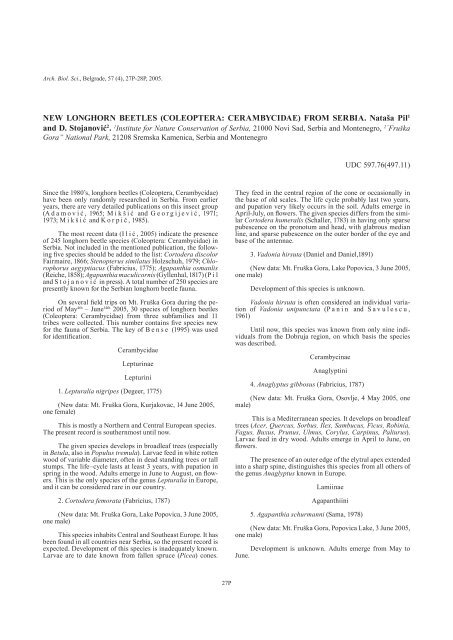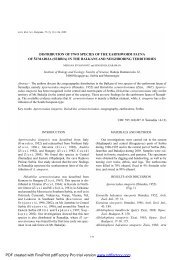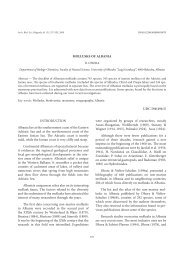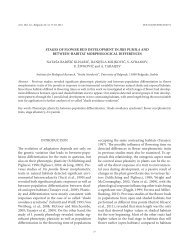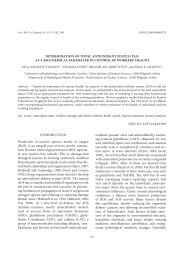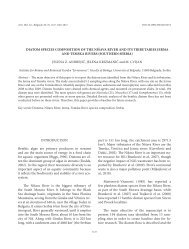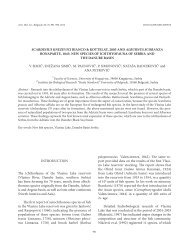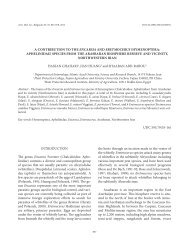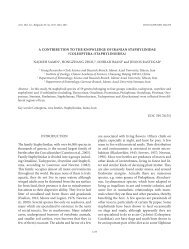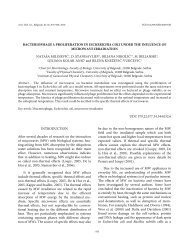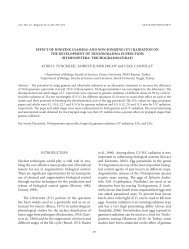NEW LONGHORN BEETLES (COLEOPTERA ... - doiSerbia
NEW LONGHORN BEETLES (COLEOPTERA ... - doiSerbia
NEW LONGHORN BEETLES (COLEOPTERA ... - doiSerbia
Create successful ePaper yourself
Turn your PDF publications into a flip-book with our unique Google optimized e-Paper software.
Arch. Biol. Sci., Belgrade, 57 (4), 27P-28P, 2005.<br />
<strong>NEW</strong> <strong>LONGHORN</strong> <strong>BEETLES</strong> (<strong>COLEOPTERA</strong>: CERAMBYCIDAE) FROM SERBIA. Nataša Pil 1<br />
and D. Stojanović 2 . 1 Institute for Nature Conservation of Serbia, 21000 Novi Sad, Serbia and Montenegro, 2” Fruška<br />
Gora” National Park, 21208 Sremska Kamenica, Serbia and Montenegro<br />
Since the 1980’s, longhorn beetles (coleoptera, cerambycidae)<br />
have been only randomly researched in Serbia. From earlier<br />
years, there are very detailed publications on this insect group<br />
(A d a m o v i ć , 1965; M i k š i ć and G e o r g i j e v i ć , 1971;<br />
1973; M i k š i ć and K o r p i č , 1985).<br />
The most recent data (I l i ć , 2005) indicate the presence<br />
of 245 longhorn beetle species (coleoptera: cerambycidae) in<br />
Serbia. Not included in the mentioned publication, the following<br />
five species should be added to the list: Cortodera discolor<br />
Fairmaire, 1866; Stenopterus similatus Holzschuh, 1979; Chlorophorus<br />
aegyptiacus (Fabricius, 1775); Agapanthia osmanlis<br />
(Reiche, 1858); Agapanthia maculicornis (Gyllenhal, 1817) (P i l<br />
and S t o j a n o v i ć in press). A total number of 250 species are<br />
presently known for the Serbian longhorn beetle fauna.<br />
On several field trips on Mt. Fruška Gora during the period<br />
of May 4th – June 14th 2005, 30 species of longhorn beetles<br />
(coleoptera: cerambycidae) from three subfamilies and 11<br />
tribes were collected. This number contains five species new<br />
for the fauna of Serbia. The key of B e n s e (1995) was used<br />
for identification.<br />
cerambycidae<br />
Lepturinae<br />
Lepturini<br />
1. Lepturalia nigripes (degeer, 1775)<br />
(New data: Mt. Fruška Gora, Kurjakovac, 14 June 2005,<br />
one female)<br />
This is mostly a Northern and central European species.<br />
The present record is southernmost until now.<br />
The given species develops in broadleaf trees (especially<br />
in Betula, also in Populus tremula). Larvae feed in white rotten<br />
wood of variable diameter, often in dead standing trees or tall<br />
stumps. The life–cycle lasts at least 3 years, with pupation in<br />
spring in the wood. Adults emerge in June to August, on flowers.<br />
This is the only species of the genus Lepturalia in Europe,<br />
and it can be considered rare in our country.<br />
2. Cortodera femorata (Fabricius, 1787)<br />
(New data: Mt. Fruška Gora, Lake Popovica, 3 June 2005,<br />
one male)<br />
This species inhabits central and Southeast Europe. It has<br />
been found in all countries near Serbia, so the present record is<br />
expected. development of this species is inadequately known.<br />
Larvae are to date known from fallen spruce (Picea) cones.<br />
27P<br />
udc 597.76(497.11)<br />
They feed in the central region of the cone or occasionally in<br />
the base of old scales. The life cycle probably last two years,<br />
and pupation very likely occurs in the soil. Adults emerge in<br />
April-July, on flowers. The given species differs from the similar<br />
Cortodera humeralis (Schaller, 1783) in having only sparse<br />
pubescence on the pronotum and head, with glabrous median<br />
line, and sparse pubescence on the outer border of the eye and<br />
base of the antennae.<br />
3. Vadonia hirsuta (daniel and daniel,1891)<br />
(New data: Mt. Fruška Gora, Lake Popovica, 3 June 2005,<br />
one male)<br />
development of this species is unknown.<br />
Vadonia hirsuta is often considered an individual variation<br />
of Vadonia unipunctata (P a n i n and S a v u l e s c u ,<br />
1961)<br />
until now, this species was known from only nine individuals<br />
from the Dobruja region, on which basis the species<br />
was described.<br />
cerambycinae<br />
Anaglyptini<br />
4. Anaglyptus gibbosus (Fabricius, 1787)<br />
(New data: Mt. Fruška Gora, Osovlje, 4 May 2005, one<br />
male)<br />
This is a Mediterranean species. It develops on broadleaf<br />
trees (Acer, Quercus, Sorbus, Ilex, Sambucus, Ficus, Robinia,<br />
Fagus, Buxus, Prunus, Ulmus, Corylus, Carpinus, Paliurus).<br />
Larvae feed in dry wood. Adults emerge in April to June, on<br />
flowers.<br />
The presence of an outer edge of the elytral apex extended<br />
into a sharp spine, distinguishes this species from all others of<br />
the genus Anaglyptus known in Europe.<br />
Lamiinae<br />
Agapanthiini<br />
5. Agapanthia schurmanni (Sama, 1978)<br />
(New data: Mt. Fruška Gora, Popovica Lake, 3 June 2005,<br />
one male)<br />
development is unknown. Adults emerge from May to<br />
June.
28P<br />
The species has been previously registered only from<br />
Greece (A l t h o f f and D a n i l e v s k i , 1977).<br />
For Mt. Fruška Gora, where all these specimens were collected,<br />
78 species were known up to now. Our two months of<br />
collecting cerambycid beetles yielded 30 species.<br />
Detailed exemination revealed five species new for the<br />
Serbian fauna: Agapanthia schurmanni Sama, 1978; Cortodera<br />
femorata (Fabricius, 1787); Vadonia hirsuta (daniel and daniel,1891);<br />
Anaglyptus gibbosus (Fabricius, 1787); and Lepturalia<br />
nigripes (De Geer, 1775).<br />
Agapanthia schurmanni (Sama, 1978) was recorded only<br />
in Greece until now. Like all Agapanthia, it has inadequately<br />
known development, mostly because specimens are hard to<br />
find.<br />
The finding of Vadonia hirsuta (daniel and daniel, 1891)<br />
is a very surprising record, considering that the only known<br />
individuals are from Romania.<br />
Lepturalia nigripes (D e G e e r , 1775) is a species from<br />
northern parts of Europe. The present record is the southernmost<br />
until now. It is the only species of the genus Lepturalia in<br />
Europe and it can be considered rare in our country.<br />
Cortodera femorata (Fabricius, 1787), and Anaglyptus<br />
gibbosus (Fabricius, 1787) are Mediterranean species whose<br />
recording in Serbia was expected.<br />
References: - Adamović, Đ. (1965). Glasnik Prirodnjačkog<br />
muzeja srpske zemlje, ser. B, XX, 147-183, Beograd. - Althoff,<br />
J., danilevski, M. L. (1997). A check-list of longicorn beetles<br />
(coleoptera, cerambycoidea) of Europe. Slovensko<br />
entomološko društvo Štefana Michielija, Ljubljana. - Bense, U.<br />
(1995). Bockkäfer: Illustrierter Schlüsel zu den ceramyciden<br />
und Vesperiden Europas (Longhorn Beetles), Margraf Verlag,<br />
Weikerscheim. - Mikšić, R. (1971). Katalog der Bockkäfer (Cerambycidae)<br />
Jugoslawiens. Institut za šumarstvo, Sarajevo.<br />
- Mikšić, R., Georgijević, E. (1971). Cerambycidae of Yugoslavia,<br />
part I. Akad. nauka i umetnosti Bosne i Hercegovine,<br />
XLIII, 3: 175. Sarajevo [in Serbian]. - Mikšić, R., Georgijević,<br />
E. (1973). Cerambycidae of Yugoslavia, part II. Akad. nauka<br />
i umetnosti Bosne i Hercegovine, XLV, 4, 1-153, Sarajevo [in<br />
Serbian]. - Mikšić, R., Korpič, M. (1985). Cerambycidae of<br />
Yugoslavia, part III. Akad. nauka i umetnosti Bosne i Hercegovine,<br />
LXII, 5, 1-148, Sarajevo [in Serbian]. - Panin, S., Savulescu,<br />
N. (1961). cerambycidae (croitori). Fauna Rep. Pop.<br />
Pomine, Insecta 10 (5), 1-523, Bucureşti.


